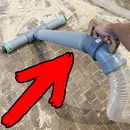Introduction: Riving Knife
The importance of a riving knife can not be underestimated! If you have ever worked with circular saws then you know what I am talking about. Without it one of the most terrifying thing called kickback can easily occur.
My Makita MLT 100 contractor table saw came with a riving knife but this one had had one big flaw that really annoyed me. To fix this issue I made a completely new one and I would like to share how I did it with you!
I also made a short video of the build. Check it out!
This project is nothing really special or complicated but I hope that someone will find it useful.
Let´s get started!
Step 1: Tools Ans Materials
You will need:
- Sheet metal with thickness bit thinner than your saw blade.
- Optional: spray paint
- Old riving knife or a template
- metal file
- drill bit
- calipers
- oil for lubrication
- steel punch and a hammer
- jigsaw with metal cutting blade
- marker
- clamp for holding your workpiece
Step 2: But Why?
As I said my original riving knife had one big flaw. It was caused by it being too tall. It was designed so that it could hold blade guard/dust extractor, but I newer used it. Yeah, I know that you are supposed to use all the safety features that come with the table saw, but I personally find it much safer when I actually see the blade at all times.
The height of the riving knifed was a big pain in the buttocks. I could only make through cuts as the knife prohibit the workpiece from moving forward. It also blocked the movement of my table saw sled. Every time I wanted to use my slede or make a groove cut I had to remove the knife. It took quite a bit of time and I did not feel too comfortable sticking my hand inside the saw next to the blade to remove the thing.
At one point it was too much for me and I decided to spend a few hours to make a new riving knife. I did not really want to just cut the old one shorter as I might want to use it's features in the future (probably not, though).
Step 3: Mark and Drill
Use your already existing riving knife to trace out the shape of a
new knife. It is a good idea to clean the metal with acetone before you start marking as it will remove any oil and dust that is on the metal. There is also a good chance that you do not have an old knife to use as a template. In that case, I can think of two possibilities. Either you find the shape by trial and error with wooden/cardboard test pieces. Or you get the template from someone like a person from woodworking forum or maybe the manufacturer might even send you one. The height of the knife should be just a tiny bit shorter than the height of the saw blade.
Use a drill bit to make holes in the correct locations.
Step 4: Mark and Cut
Use metal cutting blade and oil for lubrication to cut out the shape.
After that, it is a good idea to also use metal files to smoothen the
rough edges. After all, the saw blade is already dangerous enough - you don´t want to cut your fingers with the riving knife.
I also like to paint everything that is even remotely dangerous red so I would stay more alert around it. So I did also with my new riving knife. Be sure to use acetone to clean the blade thurally before applying the paint.
Step 5: The End
Success!
Now I can make grooved cuts and the sled works also perfectly. And also it does not stick out from the table when the blade is fully retracted. I can now easily slide my fence over without bumping into it.
I hope you liked this simple project!
Cheers
Andu













